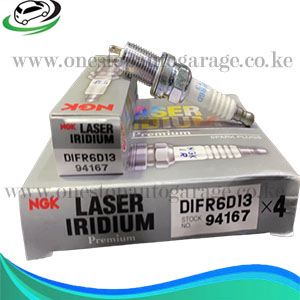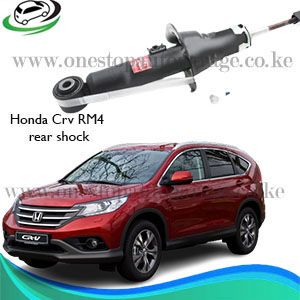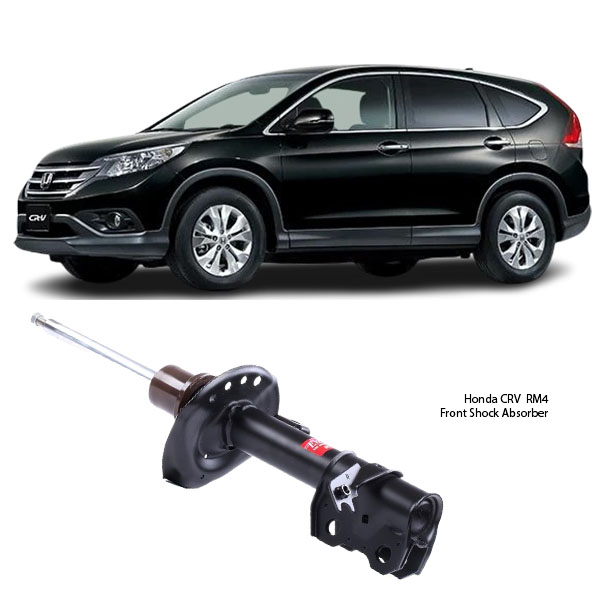-3%
Get Honda CRV RM4 Front Shock Absorber Assy 339261 in Kenya
The front shock absorber assembly is one of the most critical components in a vehicle’s suspension system, especially for ensuring safe handling, ride comfort, and vehicle stability. Found in both passenger cars and commercial vehicles, this assembly plays a vital role in managing how the vehicle responds to road irregularities, bumps, potholes, and driving forces such as acceleration, braking, and cornering.
What is a Front Shock Absorber Assembly?
The front shock absorber assembly refers to the complete unit that consists of the shock absorber (also known simply as the “shock”), its mounting components, and in many vehicles, a coil spring, strut mount, and bearing. This assembly works in harmony with other suspension parts like control arms, bushings, and the steering knuckles to provide a stable, comfortable, and safe ride.
Key Functions of the Front Shock Absorber Assembly
1. Damping Vibrations and Impacts
When your vehicle moves over uneven terrain, the wheels move up and down. Without shock absorbers, the springs would continue bouncing uncontrollably. The shock absorber regulates this movement by providing resistance to the spring’s motion. It ensures the tires remain in contact with the road, improving grip and safety.
2. Enhancing Ride Comfort
The assembly absorbs shocks from road imperfections like potholes and speed bumps, protecting passengers from feeling harsh impacts. This translates to a smoother, more comfortable ride.
3. Maintaining Vehicle Stability
Front shocks play a critical role in controlling body roll (side-to-side leaning) during cornering and reducing nose dive (when the front dips down) during braking. This keeps the vehicle composed and predictable in its handling.
4. Supporting Steering Precision
Since the front shock absorber assembly is directly connected to the steering system, its condition affects steering response, precision, and feedback. Worn or damaged shocks can make the steering feel loose and imprecise.
Components of a Front Shock Absorber Assembly
A complete front shock absorber assembly often includes:
1. Shock Absorber (Damper)
This is the cylindrical component filled with hydraulic fluid (or gas) that dampens the motion of the suspension.
2. Coil Spring (in strut-type assemblies)
This spring supports the vehicle’s weight and absorbs large impacts, working alongside the damper.
3. Strut Mount
The upper mount that connects the assembly to the vehicle’s chassis. It often includes a bearing to allow smooth rotation during steering.
4. Dust Boot
A protective cover that shields the piston rod from dirt and debris, preventing premature wear.
5. Bump Stop
A small rubber piece that limits suspension travel to prevent metal-on-metal contact during severe impacts.
6. Mounting Hardware
Nuts, bolts, and bushings that secure the assembly to the vehicle.
Types of Front Shock Absorbers
1. Twin-Tube Shock Absorber
This traditional design uses two cylinders – one inner working cylinder and an outer reserve cylinder for fluid. These are common in everyday vehicles.
2. Monotube Shock Absorber
A more performance-oriented design with a single cylinder divided into two chambers — one for hydraulic fluid and one for pressurized gas. These offer better heat dissipation and faster response.
3. Strut Assembly
Common in modern cars, a strut combines the shock absorber and coil spring into a single unit, simplifying the suspension design and saving space.
Benefits of a Healthy Front Shock Absorber Assembly
1. Improved Handling and Stability
Good shocks ensure the vehicle responds predictably to steering inputs, minimizing body roll and ensuring optimal tire contact with the road.
2. Enhanced Comfort
Absorbing road imperfections reduces jolts and vibrations, improving passenger comfort, especially on rough roads.
3. Better Braking Performance
Shocks help maintain proper weight distribution under braking, keeping the tires planted for maximum grip.
4. Reduced Tire Wear
By ensuring even tire contact and minimizing unnecessary suspension movement, well-functioning shocks help prevent uneven tire wear.
5. Protects Other Components
Healthy shocks reduce stress on suspension arms, bushings, steering linkages, and even the chassis itself.
Signs of Worn or Failing Front Shock Absorbers
-
Excessive Bouncing If the vehicle continues to bounce after hitting a bump, the shocks are likely worn.
-
Nose Dives Under Braking A worn front shock cannot properly control weight transfer, causing the front to dive excessively during braking.
-
Poor Steering Response If the steering feels vague, loose, or unstable, the front shock absorbers might be to blame.
-
Uneven Tire Wear Shocks that fail to keep the tires firmly planted can lead to cupping or scalloping on tire tread.
-
Fluid Leaks Visible oil leaks from the shock body indicate internal seal failure, requiring immediate replacement.
-
Knocking or Clunking Noises Loose or worn shock mounts, bushings, or internal components can create knocking sounds when driving over bumps.
Maintenance Tips for Front Shock Absorber Assemblies
1. Regular Inspections
Check shocks every 20,000 km (or as recommended by your manufacturer). Look for leaks, damage, and abnormal tire wear.
2. Replace in Pairs
Always replace shocks in pairs (both left and right) to maintain balanced handling and braking.
3. Check Supporting Components
Whenever replacing shocks, inspect strut mounts, bearings, control arm bushings, and ball joints. A complete repair restores full suspension performance.
4. Stick to Quality Brands
Premium shocks (KYB, Bilstein, Monroe, etc.) last longer and provide better performance compared to cheap, low-quality alternatives.
5. Consider Your Driving Conditions
If you frequently drive on rough roads or carry heavy loads, consider upgrading to heavy-duty or performance shocks.
Common Myths About Front Shock Absorbers
1. Shocks Only Affect Comfort
False — they directly impact safety, handling, and braking performance.
2. If It’s Not Leaking, It’s Fine
Not necessarily — internal wear can degrade performance long before leaks appear.
3. Shocks Last Forever
No shock absorber lasts forever. Most have a lifespan of 50,000 to 100,000 km, depending on driving conditions.
Performance Upgrades for Enthusiasts
Car enthusiasts often upgrade to performance shocks or coilovers to improve handling. These options offer:
- Adjustable damping (soft or firm ride)
- Lower ride height for better aerodynamics
- Stiffer springs for reduced body roll
- Improved heat dissipation for consistent performance under spirited driving
Conclusion
The front shock absorber assembly is much more than just a comfort-enhancer — it’s a safety-critical component that ensures your vehicle handles predictably, brakes effectively, and maintains grip on all road surfaces. Regular inspections, timely replacements, and choosing high-quality parts are essential to keep your vehicle safe and performing at its best.
Whether you drive a small hatchback, a luxury sedan, or an off-road SUV, keeping your front shock absorbers in top shape is non-negotiable. They protect your tires, your suspension, your chassis — and most importantly, your safety.
Follow us on Facebook for more parts.



